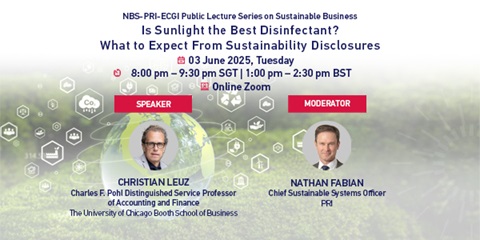Moderated by Dr Meng Zhao, Senior Research Fellow at Nanyang CEM, the webinar was attended by more than 150 registrants. The session opened with an introduction of Nanyang CEM by its Director, Professor Sam Park, who shared about Nanyang CEM’s global network of scholars and business schools which focuses on business-related issues, primarily in Southeast Asian emerging markets. He also introduced reports published by the Centre on CSV, such as “Capabilities for Creating Shared Value”.
To begin, each panellist gave a short presentation on their organisation. Ms Alex van der Ploeg, Head of Corporate Social Responsibility at SAP Inc., shared details on SAP’s sustainability journey – SAP set out a vision 10 years ago to help the world run better and improve people’s lives. Ms van der Ploeg emphasised, “Ultimately, you have to fill these words with life. And there is a lot of trial-and-error attached to that.” Since 2012, SAP has been producing
integrated reports to demonstrate their economic, social and environmental impact on the world. Putting purpose into action involves tapping into SAP’s core assets, namely their employees, technology, and ecosystem.
Lastly, Mr Kazi Huque, CEO of Technology for Social Impact (TSI), former Grameen Intel Social Business Ltd., introduced his firm as a start-up that has gradually grown over time. TSI’s journey has been documented in the book, The Rule of One. Grameen Intel started with a conversation with former Intel CEO Craig Barret on using technology to improve the livelihood of those at the base of the pyramid. The success of TSI’s projects are measured by tangible social impact, sustainability, and cost recovery, meaning that the business would at least have to cover some of the costs for the product and services they provide.
Dr Zhao asked how companies that are taking their first steps towards social impact activities can find the right project for their company. Drawing from SAP’s experience, Ms van der Ploeg shared, “Firms have to learn how to create focus and priority. This is not easy to achieve, but you have to stand firm and explain why it is important to stay on a particular project rather than another.” Ms van der Ploeg stressed that partnerships are crucial to truly creating change. Most importantly, Ms van der Ploeg reiterated that SAP has been able to set itself apart because their employees are always engaged.
Addressing a question on whether social intrapreneur can be trained, Mr Nowack suggested, “There is a special trait required to be creative in using the rigid systems of a company to create innovation. Companies can create nurturing grounds for social intrapreneur. Specifically, there needs to be a clear call of action for social intrapreneurship, clear framework for intrapreneurs to make their innovation happen and clear visibility for the social intrapreneurs who do step up. Mr Nowack raised a point on core strategy, “Social initiatives that started with the pure idea for CSR (corporate social responsibility) activity tend to be short-lived or not as transformational to the company.”
On the question of selling social purpose to external stakeholders, Ms van der Ploeg shared, “For SAP, patience and focus are two key learnings; firms have to learn that you cannot create change and mind-set shift in a short period of time.” Ultimately, firms need to understand that they would measure things very differently from the rest of the business.
Can social businesses make profit while being fully committed to solving social problems? Mr Huque emphasised that it is important to remember that one is running a business and the money must be used in a disciplined way. But unlike other business ventures, maximising profit is not the aim. “Profit is minimal and any surplus cash you make is reinvested into the business”. In essence, social business involves taking money from investors and hoping to pay them back eventually. In the meantime, firms must maintain a cost structure that is sustainable over time.
Participants were particularly interested in TSI’s business model and how they ensure cost recovery. Using TSI’s soil testing kit as an example, Mr Huque suggested thinking about cost recovery in three phases:
(i) The beneficiary—does it make business sense for the farmer,
(ii) the micro entrepreneur—can they recoup the cost, and
(iii) TSI themselves—what is your price point to provide this solution?
Mr Nowack chipped in to provide a different angle to the issue, stating that traditional businesses tend to take a top down approach to strategy and operations, but the first thing you want to create is empathy for people on the ground.
Regarding incentivising top management to address more social issues, Mr Huque reflected that one needs an executive sponsor who has influence within the corporation and has empathy for the rest of the world. Beyond that, one should understand and apply the firm’s core asset creatively and prove that they are solving a tangible problem. Ms van der Ploeg raised the example of social sabbaticals at SAP, where executives are sent to emerging markets to expose themselves to issues they might not otherwise be exposed to.
Finally, how has COVID-19 affected the panellists’ projects? Ms van der Ploeg noticed that the push and pull between being very strategic and philanthropic increased. Push back was necessary to make senior management understand that this was not the time to slow down. While it is unclear if SAP will reach the same level of social impact that they had in previous years, Ms van der Ploeg was optimistic that this is an opportunity to question how SAP has been doing things and experiment on things they have not done before.
Mr Nowack added to this when he pointed out that a lot of attention has shifted as people rethink how they can rebuild for the better. Next steps include considering what can be changed in the use of capital. As boards are held accountable, executives are enabled to also drive change. This trickle-down effect, said Mr Nowack, can affect how we create social innovations and link shareholders to the social intrapreneurs on the ground.
Wrapping up the session, Mr Huque returned to The Rule of One, stating that the book was titled as such because they realised people often romanticise the sort of social impact we can have. However, TSI’s experience had taught them that you have to reduce it to one problem, with one solution, with one community. In the case of COVID-19, the largest impact has been on the community as field workers are not able to go into the communities to run the projects. Opportunities do arise, however, as Mr Huque also shared that they are in the R&D phase of developing low cost ventilators under their healthcare focus area.
Published on 30 September 2020







